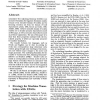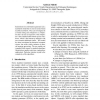33 search results - page 3 / 7 » A Tree Transducer Model for Synchronous Tree-Adjoining Gramm... |
CSB
2004
IEEE
13 years 8 months ago
2004
IEEE
Motivation: Since the whole genome sequences for many species are currently available, computational predictions of RNA secondary structures and computational identifications of t...
COGSCI
2004
13 years 4 months ago
2004
Disfluencies include editing terms such as uh and um as well as repeats and revisions. Little is known about how disfluencies are processed, and there has been next to no research...
COLING
1990
13 years 6 months ago
1990
Lexicalized Tree Adjoining Grammar (LTAG) is an attractive formalism for linguistic description mainly because cff its extended domain of locality and its factoring recursion out ...
NAACL
2010
13 years 2 months ago
2010
Synchronous tree substitution grammars are a translation model that is used in syntax-based machine translation. They are investigated in a formal setting and compared to a compet...
ACL
2011
12 years 8 months ago
2011
We introduce synchronous tree adjoining grammars (TAG) into tree-to-string translation, which converts a source tree to a target string. Without reconstructing TAG derivations exp...


